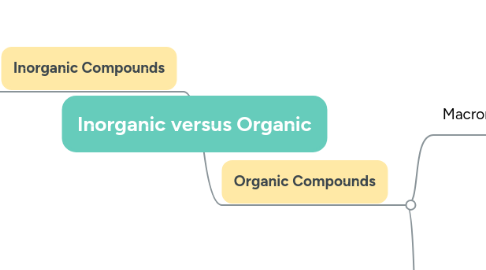
1. Inorganic Compounds
1.1. Components
1.1.1. ACIDS
1.1.1.1. Electrolyte
1.1.1.2. Dissociate in water
1.1.1.3. Releases hydrogen ions H+
1.1.1.4. Lower pH
1.1.2. SALTS
1.1.2.1. Ionic compounds
1.1.2.2. No H+ or OH-
1.1.2.3. Electrolyte
1.1.2.3.1. Ability to conduct electrical currents in solution
1.1.2.4. Necessary for homeostasis
1.1.3. WATER
1.1.3.1. Most abundant
1.1.3.1.1. 60-80% of living cells
1.1.3.2. High heat capacity
1.1.3.2.1. Able to absorb and release heat with little temperature change
1.1.3.2.2. Prevents sudden change in temperature
1.1.3.3. High heat of vaporization
1.1.3.3.1. Evaporation needs lots of heat
1.1.3.3.2. Cools body down = homeostasis
1.1.3.4. Polar solvent properties
1.1.3.4.1. Dissolves and dissociates ionic substances (NaCl)
1.1.3.4.2. Forms hydration layers around charged molecules
1.1.3.4.3. Transportation
1.1.3.5. Reactivity
1.1.3.5.1. Hydrolysis: adding water to break down bonds
1.1.3.5.2. Dehydration: removing water to create bonds
1.1.3.6. Cushioning
1.1.3.6.1. Protects organs from physical trauma
1.1.4. BASES
1.1.4.1. Proton acceptor
1.1.4.2. Take hydrogen ions H+
1.1.4.3. Higher pH
1.2. Do not contain carbon
1.3. CO2 and CO exceptions
2. Organic Compounds
2.1. Macromolecules
2.1.1. Carbohydrates
2.1.1.1. Contain C, O, and H
2.1.1.2. 2 H for every 1 O
2.1.1.3. Three classes
2.1.1.3.1. Monosaccharides
2.1.1.3.2. Disaccharides
2.1.1.3.3. Polysaccharides
2.1.2. Lipids
2.1.2.1. Contains H, O, less C
2.1.2.1.1. Sometimes P
2.1.2.2. Main types
2.1.2.2.1. Tryglycerides
2.1.2.2.2. Steroids
2.1.2.2.3. Eicosanoids
2.1.2.3. Hydrophobic
2.1.2.3.1. Insoluble in water
2.1.3. Proteins
2.1.4. Nucleic Acids
2.2. Contains carbon
2.2.1. Electroneutral
2.2.1.1. Shares electrons
2.2.1.2. Forms 4 covalent bonds
2.2.1.3. Unique to living systems

